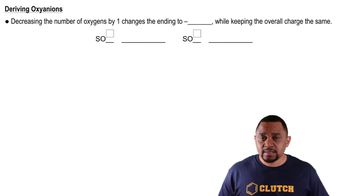Here are the essential concepts you must grasp in order to answer the question correctly.
Ionic Compounds
Ionic compounds are formed when atoms transfer electrons, resulting in the formation of positively charged cations and negatively charged anions. These oppositely charged ions attract each other, creating a stable compound. Understanding the nature of ionic bonds is essential for naming and writing formulas for ionic compounds.
Recommended video:
Nomenclature of Ionic Compounds
The nomenclature of ionic compounds involves specific rules for naming the cations and anions. Typically, the cation retains its elemental name, while the anion's name is derived from its elemental name, often modified with an '-ide' suffix for simple anions. For transition metals, the oxidation state is indicated using Roman numerals.
Recommended video:
Polyatomic Ions
Polyatomic ions are ions composed of two or more atoms covalently bonded together, which carry a net charge. They play a crucial role in ionic compounds, as they can replace simple anions in compound formulas. Recognizing common polyatomic ions, such as nitrate (NO3-) and chromate (CrO4^2-), is vital for correctly naming and writing formulas for ionic compounds.
Recommended video:
Polyatomic Ion Variations
 Verified step by step guidance
Verified step by step guidance


